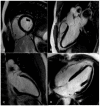The Applications of Artificial Intelligence in Cardiovascular Magnetic Resonance-A Comprehensive Review
- PMID: 35628992
- PMCID: PMC9147423
- DOI: 10.3390/jcm11102866
The Applications of Artificial Intelligence in Cardiovascular Magnetic Resonance-A Comprehensive Review
Abstract
Cardiovascular disease remains an integral field on which new research in both the biomedical and technological fields is based, as it remains the leading cause of mortality and morbidity worldwide. However, despite the progress of cardiac imaging techniques, the heart remains a challenging organ to study. Artificial intelligence (AI) has emerged as one of the major innovations in the field of diagnostic imaging, with a dramatic impact on cardiovascular magnetic resonance imaging (CMR). AI will be increasingly present in the medical world, with strong potential for greater diagnostic efficiency and accuracy. Regarding the use of AI in image acquisition and reconstruction, the main role was to reduce the time of image acquisition and analysis, one of the biggest challenges concerning magnetic resonance; moreover, it has been seen to play a role in the automatic correction of artifacts. The use of these techniques in image segmentation has allowed automatic and accurate quantification of the volumes and masses of the left and right ventricles, with occasional need for manual correction. Furthermore, AI can be a useful tool to directly help the clinician in the diagnosis and derivation of prognostic information of cardiovascular diseases. This review addresses the applications and future prospects of AI in CMR imaging, from image acquisition and reconstruction to image segmentation, tissue characterization, diagnostic evaluation, and prognostication.
Keywords: artificial intelligence; cardiac magnetic resonance; deep learning; machine learning.
Conflict of interest statement
The authors declare no conflict of interest.
Figures








Similar articles
-
From Acquisition to Prognosis: The Role of AI in Cardiac Magnetic Resonance Imaging Evaluation of Ischemic Cardiomyopathy.Echocardiography. 2025 Jun;42(6):e70201. doi: 10.1111/echo.70201. Echocardiography. 2025. PMID: 40483710 Review.
-
Artificial Intelligence in Nuclear Cardiac Imaging: Novel Advances, Emerging Techniques, and Recent Clinical Trials.J Clin Med. 2025 Mar 19;14(6):2095. doi: 10.3390/jcm14062095. J Clin Med. 2025. PMID: 40142902 Free PMC article. Review.
-
The role of artificial intelligence in cardiovascular magnetic resonance imaging.Prog Cardiovasc Dis. 2024 Sep-Oct;86:13-25. doi: 10.1016/j.pcad.2024.06.004. Epub 2024 Jun 24. Prog Cardiovasc Dis. 2024. PMID: 38925255 Review.
-
Artificial Intelligence in Cardiac MRI: Is Clinical Adoption Forthcoming?Front Cardiovasc Med. 2022 Jan 10;8:818765. doi: 10.3389/fcvm.2021.818765. eCollection 2021. Front Cardiovasc Med. 2022. PMID: 35083303 Free PMC article. Review.
-
Artificial Intelligence in Cardiovascular CT and MR Imaging.Life (Basel). 2023 Feb 11;13(2):507. doi: 10.3390/life13020507. Life (Basel). 2023. PMID: 36836864 Free PMC article. Review.
Cited by
-
A study on the application of radiomics based on cardiac MR non-enhanced cine sequence in the early diagnosis of hypertensive heart disease.BMC Med Imaging. 2024 May 27;24(1):124. doi: 10.1186/s12880-024-01301-9. BMC Med Imaging. 2024. PMID: 38802736 Free PMC article.
-
Artificial Intelligence in Cardiology: Why So Many Great Promises and Expectations, but Still a Limited Clinical Impact?J Clin Med. 2023 Apr 6;12(7):2734. doi: 10.3390/jcm12072734. J Clin Med. 2023. PMID: 37048817 Free PMC article.
-
Improving the efficiency and accuracy of cardiovascular magnetic resonance with artificial intelligence-review of evidence and proposition of a roadmap to clinical translation.J Cardiovasc Magn Reson. 2024 Winter;26(2):101051. doi: 10.1016/j.jocmr.2024.101051. Epub 2024 Jun 22. J Cardiovasc Magn Reson. 2024. PMID: 38909656 Free PMC article. Review.
-
Fully automatic cardiac four chamber and great vessel segmentation on CT pulmonary angiography using deep learning.Front Cardiovasc Med. 2022 Sep 26;9:983859. doi: 10.3389/fcvm.2022.983859. eCollection 2022. Front Cardiovasc Med. 2022. PMID: 36225963 Free PMC article.
-
Application of a Deep Learning Approach to Analyze Large-Scale MRI Data of the Spine.Healthcare (Basel). 2022 Oct 26;10(11):2132. doi: 10.3390/healthcare10112132. Healthcare (Basel). 2022. PMID: 36360473 Free PMC article.
References
-
- Pontone G., Andreini D., Bertella E., Baggiano A., Mushtaq S., Loguercio M., Segurini C., Conte E., Beltrama V., Annoni A., et al. Impact of an intra-cycle motion correction algorithm on overall evaluability and diagnostic accuracy of computed tomography coronary angiography. Eur. Radiol. 2016;26:147–156. doi: 10.1007/s00330-015-3793-1. - DOI - PubMed
-
- Guaricci A.I., Maffei E., Brunetti N.D., Montrone D., Di Biase L., Tedeschi C., Gentile G., Macarini L., Midiri M., Cademartiri F., et al. Heart rate control with oral ivabradine in computed tomography coronary angiography: A randomized comparison of 7.5 mg vs 5 mg regimen. Int. J. Cardiol. 2013;168:362–368. doi: 10.1016/j.ijcard.2012.09.041. - DOI - PubMed
-
- Pontone G., Weir-McCall J.R., Baggiano A., Del Torto A., Fusini L., Guglielmo M., Muscogiuri G., Guaricci A.I., Andreini D., Patel M., et al. Determinants of Rejection Rate for Coronary CT Angiography Fractional Flow Reserve Analysis. Radiology. 2019;292:597–605. doi: 10.1148/radiol.2019182673. - DOI - PubMed
-
- Pontone G., Andreini D., Guaricci A.I., Guglielmo M., Baggiano A., Muscogiuri G., Fusini L., Soldi M., Fazzari F., Berzovini C., et al. Quantitative vs. qualitative evaluation of static stress computed tomography perfusion to detect haemodynamically significant coronary artery disease. Eur. Heart. J. Cardiovasc. Imaging. 2018;19:1244–1252. doi: 10.1093/ehjci/jey111. - DOI - PubMed
Publication types
LinkOut - more resources
Full Text Sources
Other Literature Sources

